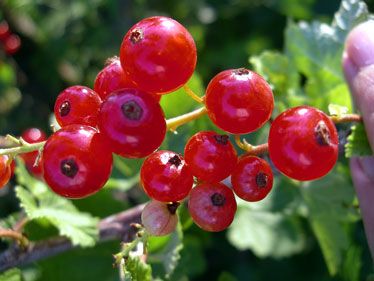Growing & Using Redcurrents

A previous article about strawberries mentioned that redcurrants were really good for helping strawberry jam to set. So this article is about redcurrants. Redcurrants are very rewarding fruit to grow, not least because it is so difficult to buy them in supermarkets.
Growing redcurrants
Redcurrants are quite easy to grow, and autumn is the best time to plant them. They need neutral to slightly acid soil, which is most soils apart from very chalky ones, so you’ll probably be fine. If in doubt, buy a pH testing kit, and check. If necessary, you can grow your redcurrants in containers. Use a loam-based compost, such as John Innes No 3, which you can buy from topsoil suppliers or garden centres. (to buy topsoil online click here)
They like to be in a sheltered site, out of strong winds and in full sun, so pick your spot carefully. For a reasonable yield, you’ll probably need two bushes. Getting two different varieties means that you’ll probably have a slight gap in picking times. There is a huge amount of advice available about how to prune redcurrants, including different things to do in year 1, 2 and so on. But in practice, if you remember to prune in late winter before the plants start to grow, and that you are aiming for a shape like an open cup, with space in the centre for light and moisture to get in, without any crossing branches, you and your redcurrants will be just fine!
The only other thing to remember is to net ripening fruit, or the birds could get to it before you do!
Using redcurrants
Redcurrants are surprisingly versatile fruit. Although a bit sharp to eat uncooked, they add a lovely flavour to stewed summer fruits, or in summer pudding. My children are particularly fond of fruits of the forest frozen yoghurt. Delightfully simple, this recipe contains just 250g of frozen mixed blackberries, raspberries, redcurrants and blackcurrants, whizzed up in a food processor with 110g of icing sugar and 100g of Greek-style yoghurt, all of which is then frozen.
You can also add redcurrants to raspberry or strawberry jam. Use sugar and redcurrants in a ratio of one to one, and just add into a standard jam recipe. Alternatively, redcurrant jelly is simplicity itself to make: use equal quantities of redcurrants and sugar; 2lb of each is a good starting point. There is no need to pick over the fruit or remove stalks, just cook it gently for about 10 minutes, while warming the sugar in the oven, then add the warmed sugar to the fruit. Once the sugar is dissolved, boil for 8 minutes, then pass it through a muslin jelly bag or sieve lined with muslin and put in jars immediately. Simple!
